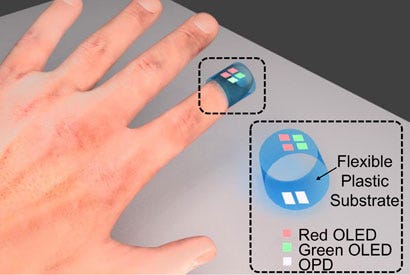In the Future, Pulse Oximeters Could Be Wearable and Disposable
December 12, 2014
|
The pulse oximeter sensor prototype makes use of organic electrodes. |
Fitness-tracking wearables are all the rage now. While most of the devices primarily monitor basic activity levels, a growing number of devices, such as Apple's forthcoming iWatch are adding pulse and number of calories burned to those list of metrics.
Researchers at University of California, Berkeley are laying the groundwork to enable future wearables to track blood-oxygen levels as well.
While a number of pulse oximeters are on the market that can gauge both blood-oxygen saturation and pulse, those products aren't exactly wearable like a FitBit is. "[T]hose devices use rigid conventional electronics, and they are usually fixed to the fingers or earlobe," said Ana Arias, an associate professor of electrical engineering and computer sciences
To solve this problem, the researchers are working with organic electronics to develop a carbon-based organic device that could serve as a thin, inexpensive, and flexible fitness tracking device, according to a news release from the university.
Researchers switched from a silicone-based design, to an organic carbon-based one to create a device that could be inexpensive, thin, and flexible, so it could be applied to the skin like a Band-Aid. Engineers put the new prototype up against a conventional pulse oximeter and found that the pulse and oxygen readings were just as accurate. The findings of their research were reported in this month's issue of Nature Communications.
Traditionally, pulse oximeter devices use light-emitting diodes (LEDs) to send red and infrared light through a fingertip or earlobe. The sensors then detect how much light makes it through the other side. Bright, oxygen-rich blood absorbs more infrared light, while the darker hues of oxygen-poor blood absorb more red light. The ratio of the two wavelengths can help reveal how much oxygen is in the blood.
For these organic sensors, the research team used red and green light, which yield comparable differences to red and infrared light when it comes to distinguishing high and low levels of oxygen in the blood. Using a processing system, the team deposited the green and red organic LEDs, and the translucent light detectors onto a flexible piece of plastic. By detecting the pattern of fresh arterial blood flow, the device can even calculate a pulse.
The group's device isn't the only spin on fitness tracking of course. Earlier this year LG released a pair of earbuds that uses similar technology to measure heart rate levels, among other vital signs.
As for the new organic sensor developed by Arias and her team, they continue to work to develop the technology to provide a cheap and effective alternative to pulse oximeters currently on the market. She even notes that the current oximeters can be so expensive, that many healthcare providers choose to sterilize and reuse them to avoid the rising costs of purchasing new devices. She believes this technology could provide a cost-effective solution because the organic properties are both cheap and flexible.
"Because organic electronics are flexible, they can easily conform to the body," she said. "Organic electronics are cheap enough that they are disposable, like a Band-Aid after use." The group is hopeful that the technology could be a significant step in the direction of affordable organic materials serving as the basis of the wearable technologies of the future.
Refresh your medical device industry knowledge at MD&M West, in Anaheim, CA, February 10-12, 2015. |
Kristopher Sturgis is a contributor to Qmed and MPMN.
Like what you're reading? Subscribe to our daily e-newsletter.
About the Author(s)
You May Also Like


